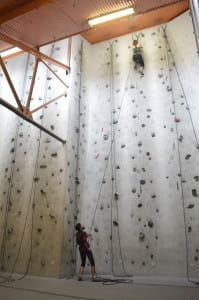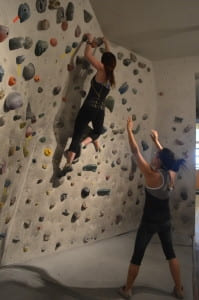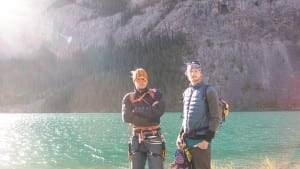Suspended 35 ft. in the air could easily be 1000 ft. the way I’m shaking. My heart is beating in my ears, my palms are sweaty, and I’m left wondering why the hell I am rock climbing when I’m terrified of heights.
Georgia Esporlas, an instructor with Joe Rockhead’s, an indoor rock climbing facility in Toronto, shouts up to me from below, “It is time for you to rappel down. You need to take your hands from the wall and sit back.” Every fibre of my being was telling me not to follow those instructions. I understand somewhere underneath the currents of fear overwhelming my brain that my terror is illogical and I’m not going to die. But I still can’t manage to do it. Esporlas informs me that it is necessary. I am already at the top of the wall and I have no other choice.

So, I let go of the wall. Suddenly, this debilitating fear slowly ceases to control me. Deep breathing helps. I close my eyes and sit back to be rappelled back down. After I get to the bottom, all I want to do is go up again. How can this be explained? What is this deep desire to expose myself to my profound fear of heights for a second time?
Joe Rockhead’s Indoor Climbing has been open since June 1992 and is a labyrinth of wicked climbing terrain. The facility is tucked away in Liberty Village in a large factory building with a 32 ft. ceiling. The rock climbing gym is home to a variety of climbers ranging from bouldering enthusiasts to lead climbers.
Bouldering doesn’t use ropes and is lower to the ground, but it can be just as challenging. “When you are bouldering, you have to make sure the rock doesn’t own you,” explains Esporlas. “Make sure you can hold onto it. Don’t climb what you can’t jump off of and try to land flat.”
Even with these tips, my first rock climbing lesson at Joe Rockhead’s reflects how difficult it is to master the variety of routes that instructors change weekly to keep climbers engaged. We move to top-roping, notably the safest form of climbing; I learn how to tie the proper knots and belay safely; and then I begin climbing.

My instructor has been climbing for over 20 years and I recommend her ten times over as an instructor if you venture over to Joe’s for a lesson. She previously competed professionally and has climbed all over the world — her favourite place to climb is in Thailand by the beach. She has skydived 55 times and is a self-noted “adrenaline junkie,” but when I inform her that I am scared of heights, she shockingly responds with “I used to be scared of heights too”.
Esporlas advises to face the fear head-on.
“The more you climb, the more you get comfortable with it. Once you overcome it, the fear just passes through you. It is such a personal journey. It doesn’t matter whether it is climbing or sky diving. It is the heights, it is trust issues within yourself and your partner who is belaying with you.”
Climbing enthusiast Joel Woodhouse agrees. “The first initial reaction I get for being a mountain climber is ‘you are crazy’,” he said. “That comes from people not understanding how it works. People often think it is solo climbing. I’m not climbing to die, I’m climbing to live.”
Woodhouse hails from Calgary, AB. and began climbing in his early 20’s. He previously worked at Crux Climbing Centre in Calgary from 2011 to 2016, and has been dedicated to outdoor climbing for seven years. Woodhouse describes rock-climbing as not just a sport, but a way of life.
The climb hasn’t always been easy. One fated day in 2010, Woodhouse was traditional climbing, a challenging form of climbing where you set the route as you go, and he fell 25 ft.
“I had a big fall and broke my left ankle. I was in a wheelchair for a month and had a couple of surgeries on my foot,” he recalled. “I fell because I did a number of things that created a lot of slack. Initially, I didn’t feel the smash. It was a minute or two later that I felt the pain and reality set in.”
Luckily, Woodhouse was with three other climbers and one of his colleagues built a rope swing so they could carry him out. “Every time the swing jolted, I felt the bone clicking as I moved. It was very painful.”
The accident didn’t make him want to quit though. He was back on the wall in no time, with an air cast still on his foot.
“Climbing didn’t do that to me, I did that because of my lack of experience and arrogance. I felt like it was something I had chosen,” said Woodhouse. “It’s a lifestyle. To not climb after that obstacle would have led to other barriers in my life.”

Interestingly, climbers throughout history have described a similar feeling towards climbing. It appears to be that as much as the people choose the mountain, it chooses you as well.
To a much less heroic extent, my desire to get back on the wall felt strangely like a pull. It was as if there was some part of me that knew I needed to overcome my fear of heights and my fear of letting go. Needless to say, I bought a membership to Joe Rockhead’s and hope to climb outdoors once my fear is lessened.
“It’s a time when you are pushing yourself. Reality drifts away. You come into contact with your soul and it is very empowering,” says Woodhouse. “The fear starts to creep up, but survival is a catalyst. I’m not going to fall so I have to make the next move. It pushes limits and you aren’t bound by the physical realities of this world anymore.”
